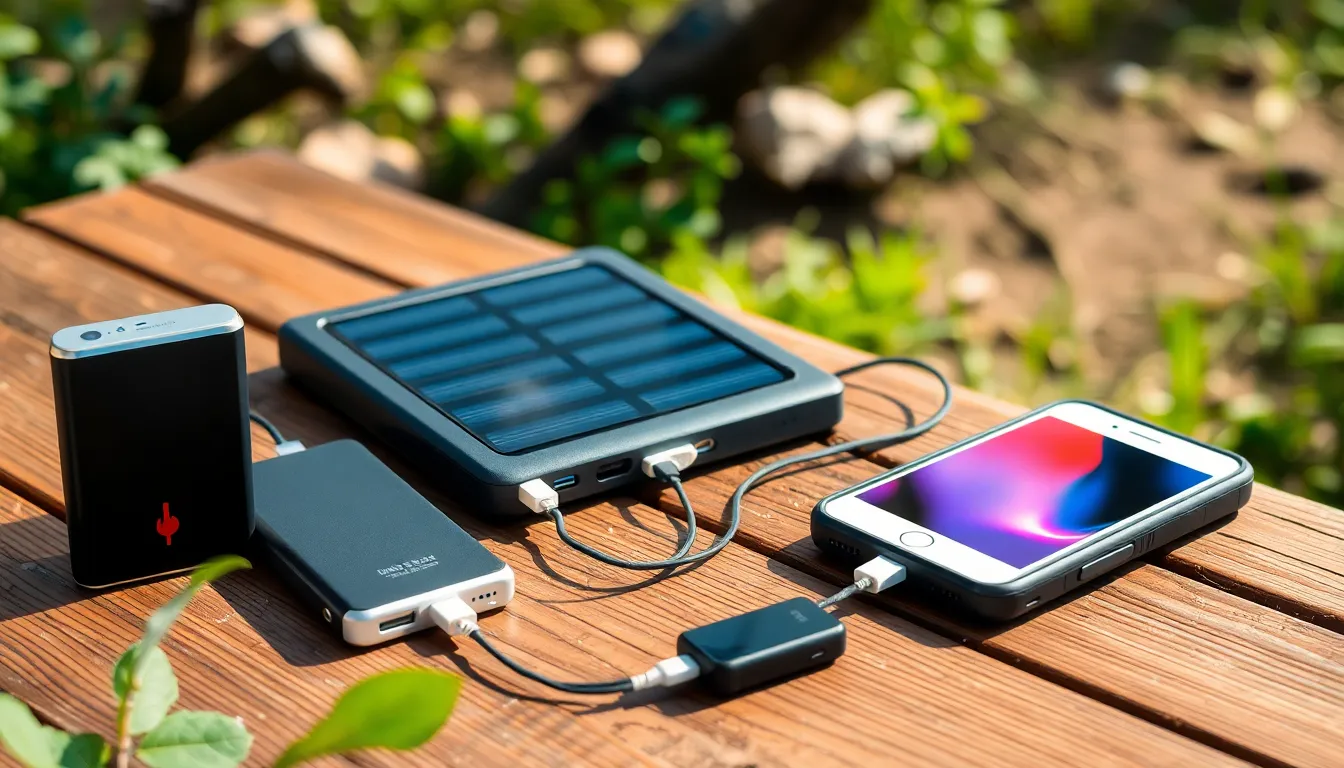Table of Contents
ToggleIn a world where smartphones are practically glued to our hands, nothing’s worse than that dreaded low-battery warning. Picture this: you’re out and about, ready to capture the perfect selfie or binge-watch your favorite show, and suddenly, your phone’s gasping for power. Enter portable chargers—the unsung heroes of modern life.
Overview of Portable Chargers
Portable chargers serve as reliable solutions for individuals facing low-battery situations on devices. These compact power banks provide convenience, allowing users to recharge smartphones, tablets, and other gadgets on the go. Various types exist, including lithium-ion and solar-powered options, catering to different preferences and needs.
Users often seek the capacity of portable chargers measured in milliampere-hours (mAh). Common capacities range from 5,000 mAh for light users to 20,000 mAh or more for those requiring extensive power. High-capacity models can deliver multiple charges before needing a recharge themselves.
Multiple ports have become a standard feature, enabling the charging of several devices simultaneously. Owners of multiple gadgets appreciate this versatility, especially during travel or group outings. Fast-charging technology also enhances efficiency, significantly reducing the time taken to power devices.
Materials for portable chargers vary widely, impacting weight and durability. Some models offer lightweight designs ideal for travel, while others provide rugged cases built for outdoor adventures. Assessing design and build quality helps in selecting the right charger for specific lifestyles or activities.
While choosing a portable charger, compatibility remains crucial. Many devices require specific charging protocols to function correctly. An understanding of individual device requirements ensures users select chargers that meet their unique charging needs effectively.
Ultimately, portable chargers enhance convenience and connectivity in today’s technology-dependent world. As individuals engage with their devices throughout the day, these gadgets stand ready to provide crucial power when it’s most needed.
Types of Portable Chargers

Portable chargers come in various types, each designed to meet different user needs and preferences. Understanding these types helps users select the most suitable power solution for their devices.
Power Banks
Power banks represent the most common type of portable charger. Users can find them in various capacities, typically measured in milliampere-hours. Those requiring minimal power often choose models around 5,000 mAh, while heavy users prefer options exceeding 20,000 mAh. Multiple ports on many power banks allow for simultaneous charging of various devices. Fast charging capabilities further enhance the user experience, significantly reducing downtime. Brands often emphasize lightweight designs for travel convenience, while some models offer ruggedness for outdoor use.
Solar Chargers
Solar chargers leverage sunlight to generate power, making them ideal for users in outdoor settings. These chargers feature solar panels that convert solar energy into electrical energy. Efficiency varies based on the quality of solar cells and sunlight exposure. Many models come with built-in power banks, enabling storage of energy for later use. Users appreciate the eco-friendly aspect of solar chargers, as they reduce reliance on conventional electricity. Camping trips and hikes see a significant benefit from this type of charger, providing power with minimal environmental impact.
Battery Cases
Battery cases integrate charging capabilities directly into the protective case of smartphones. Unlike traditional chargers, these cases offer dual functionality, protecting devices while providing additional power. Various designs are available, catering to different phone models. Users benefit from a seamless charging experience, as battery cases eliminate the need for separate chargers. Many options feature LED indicators to show remaining battery life. Overall, battery cases are perfect for users who value convenience and want to keep their devices powered without carrying extra equipment.
Features to Consider
Evaluating portable chargers involves several key features. Each aspect significantly impacts user experience and device compatibility.
Capacity
Capacity directly influences how many charges a user can obtain. The scale typically ranges from 5,000 mAh for casual users to over 20,000 mAh for heavy users. Choosing a charger with higher capacity often ensures multiple device charges on a single power bank. It’s important to match capacity with personal usage patterns, especially for frequent travelers or outdoor enthusiasts. Users often prefer brands that specify the number of full charges possible for specific devices, which aids in making informed decisions.
Size and Weight
Size and weight play crucial roles in portability. Users typically seek lightweight options for convenient carrying. Compact designs often fit easily into bags or pockets, allowing for seamless transportation. Heavier models may offer more capacity but can be cumbersome. Individuals often evaluate the balance between size and power to find the best fit for their lifestyle. Portable chargers that prioritize both functionality and ease of use enhance user satisfaction during travel or outdoor activities.
Charging Speed
Charging speed significantly affects the efficiency of recharging devices. Fast-charging functionalities expedite the replenishment of power when users are in a hurry. Many portable chargers now support various fast-charging standards, such as Quick Charge or Power Delivery. Not all devices may be compatible with these technologies, so checking for compatibility is essential. Users frequently appreciate chargers that provide information on charging times for different devices, ensuring they can make the best choices based on their needs.
Benefits of Using Portable Chargers
Portable chargers provide numerous advantages for users in a technology-driven environment. Flexibility in charging options emerges as a key benefit, allowing individuals to recharge devices anywhere. These chargers help maintain connectivity during travel, eliminating the worry of draining batteries during crucial moments.
Enhanced convenience plays a significant role in the appeal of portable chargers. Users can easily slip these compact devices into bags or pockets for on-the-go access. Many portable chargers feature multiple outputs, enabling simultaneous charging for various gadgets, such as smartphones and tablets.
Size and capacity customization cater to diverse user needs. Low-capacity options, like those with 5,000 mAh, serve casual users well. Higher-capacity models, with over 20,000 mAh, offer extensive power for heavy users or long trips.
Fast charging capabilities also enhance user experience. Numerous portable chargers support quick-charging protocols, significantly reducing downtime while devices refill their batteries. This feature benefits busy individuals who require rapid energy boosts during tight schedules.
Finally, the variety of charging solutions ensures compatibility with different devices. Users can select chargers tailored to specific needs, whether for outdoor activities or daily commuting. This adaptability solidifies the essential role of portable chargers in maintaining productivity and connectivity across various lifestyles.
Portable chargers have become indispensable in today’s fast-paced world. They offer a practical solution to the all-too-common low-battery dilemma. With various options available users can easily find a charger that fits their specific needs whether for casual daily use or extensive travel.
The versatility of portable chargers means they cater to a wide range of lifestyles. From lightweight power banks to rugged solar chargers there’s a perfect match for everyone. Fast charging capabilities and multiple ports enhance convenience making it easier to stay connected wherever life takes you.
Investing in a quality portable charger not only ensures devices remain powered but also enhances overall productivity. As technology continues to evolve these compact power sources will remain essential tools for maintaining connectivity and convenience on the go.




